#Hümaşah Sultan (Daughter of Mihrimah)
Text

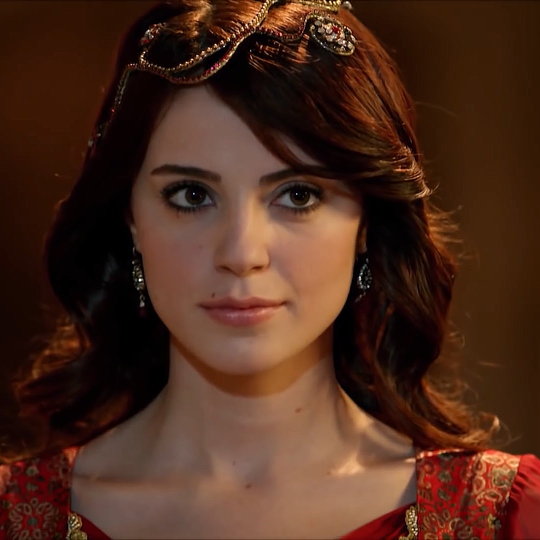
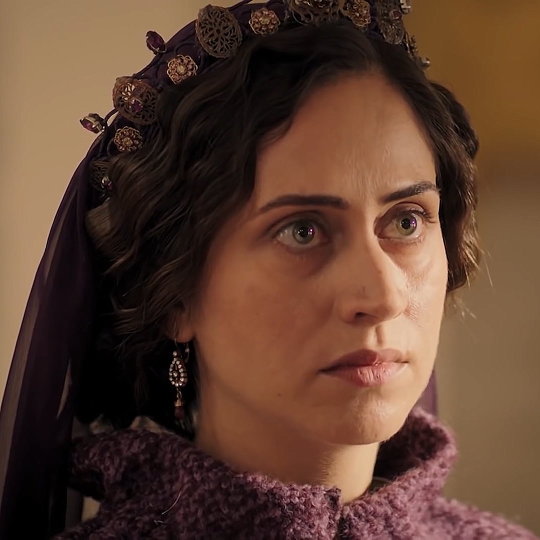
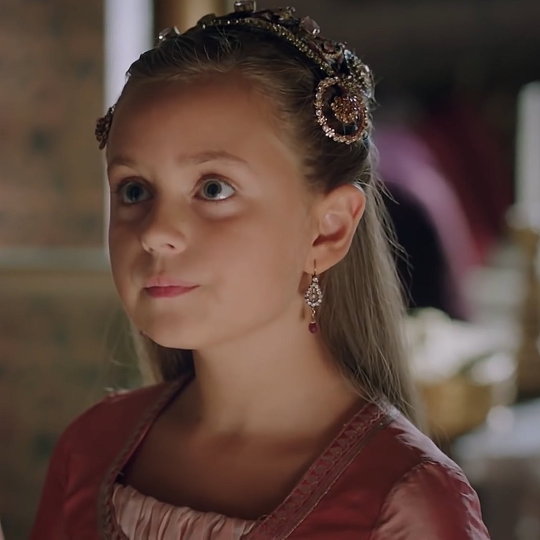
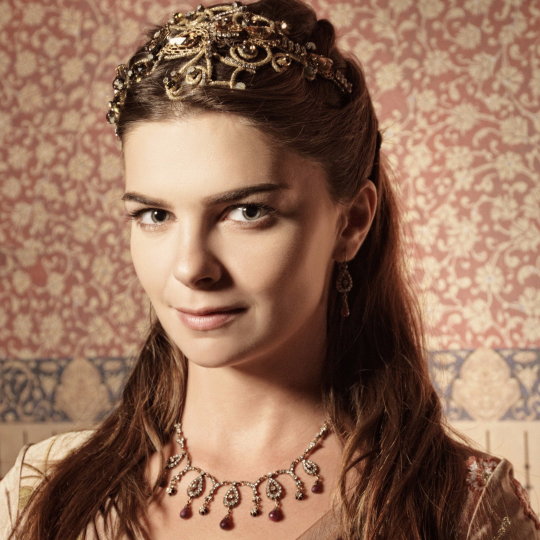
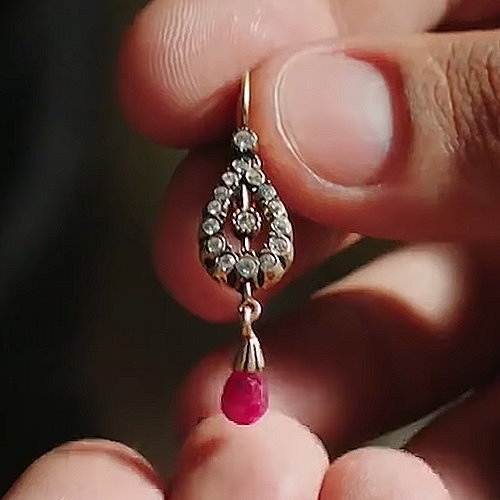
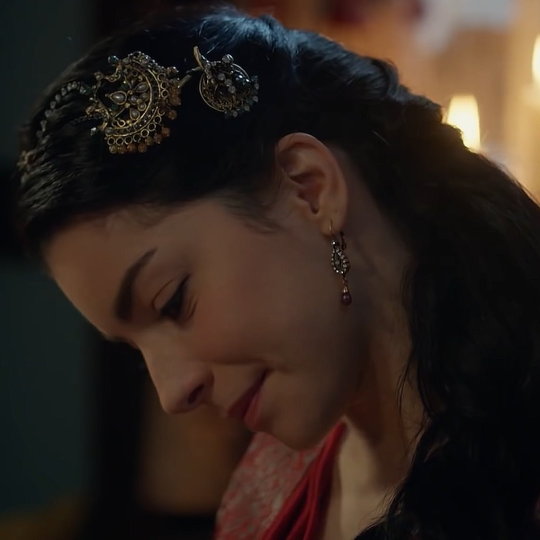

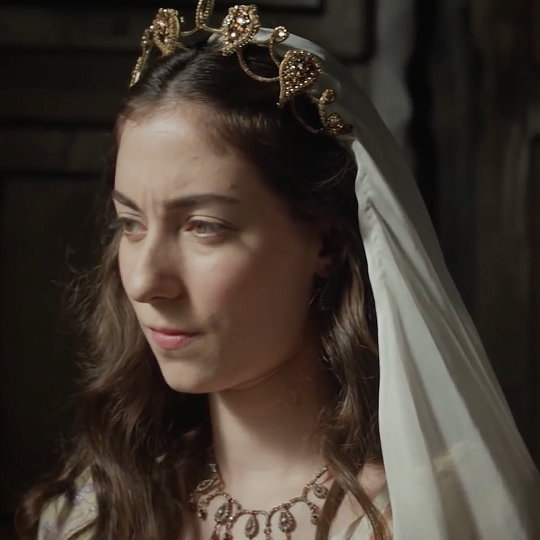
These silver earrings with a pink stone was first worn by Mahidevran Sultan in the twenty-third episode of the second season of Magnificent Century. Two episodes later, they appeared again on Aybige Hatun. The earrings can then be seen on Gülfem Hatun in the thirty-sixth episode of the same season. They were also worn by Mihrimah Sultan in the fourth episode of the third season as well as by an older Mihrimah in promotional material of the same season.
The earrings become part of the plot in the thirty-seventh episode when they are used to identify Nigar Hatun as the kidnapper. However, Nigar does not wear them in the thirty-sixth episode when the viewer saw her commit the crime.
The earrings appear three times in the fourth season, first on Nurbanu Sultan in the eighth episode, then on Defne Sultan in the twenty-eighth episode and lastly on Hümaşah Sultan in the final episode.
#Muhteşem Yüzyıl#Magnificent Century#period drama#costume drama#historical drama#Mahidevran Sultan#Aybige Hatun#Gülfem Hatun#Gulfem Hatun#Mihrimah Sultan#Mihrimah Sultan (Daughter of Hürrem)#Nigar Hatun#Nigar Kalfa#Nurbanu Sultan#Defne Sultan#Hümaşah Sultan#Humasah Sultan#Hümaşah Sultan (Daughter of Mihrimah)#Ayşe Hümaşah Sultan#Ayse Humasah Sultan#Ayşe Hümaşah Sultan (Daughter of Mihrimah)#reused jewellery#recycled jewellery
15 notes
·
View notes
Text
~Hümaşah Sultan~
Hümaşah was born Manisa. She might be born in autumn 1543 during visit of Hürrem Sultan or she might be posthume child of Sehzade Mehmed. According to historian Alderson, her mother's name was Aya. It is known that Aya was married off to Pertev Pasha. After Sehzade Mehmed's death, Hümaşah and Aya Hatun moved from Manisa to Istanbul, Old Palace. Hümaşah was close to her grandparents and her cousin, Ayşe Hümaşah, daughter of Mihrimah Sultan and Rüstem Paşa. Perhaps, both girls were educated together. Both of them were close to their uncle Sehzade Cihangir. Apparently an outgoing personality, the teenage Changir was the perfect uncle to his nieces.
In 1566/1567 Hümaşah was married off to the third Vezir, Ferhad Paşa. The marriage lasted 8-9 years till Ferhat Pasha's death on 06. January 1575. The ceremony took place in the Old Palace. From marriage with Ferhad Pasha she had several children. The known ones are: Sultanzade Hüsni, Sultanzade Osman, Fatma Hanimsultan, Sultanzade Ibrahim, Sultanzade Mustafa. They had at least 4 more daughters but the names are unknown, probably because they didn't reached adulthood. It appears that some of the childern were twins. In August 1575, Hümasah remarried to Sokolluzade Lala Mustafa Pasha. But the marriage lasted also till Lala Mustafa Pasha's death, on 7. August 1580. They had a son Sultanzade Sokolluzade Abdülbaki. Her third marriage took place in 1581 with Gaazi Mehmed Pasha who outlived Hümasah. They didn't have children together.Hümasah sultan also educated and trained Safiye and presented her to her cousin Murad, son of Selim Il and Nurbanu. Safiye lived in Hümasah's household after her abduction but Safiye's role in Hümasah's household is still unclear.
Hümasah Sultan died in 1582, the cause of death is unknown. She is buried in Shezade Mosque. The Mosque was built in honor of Hümasah's father, Sehzade Mehmed.
Her children are also buried in Sehzade's mosque.
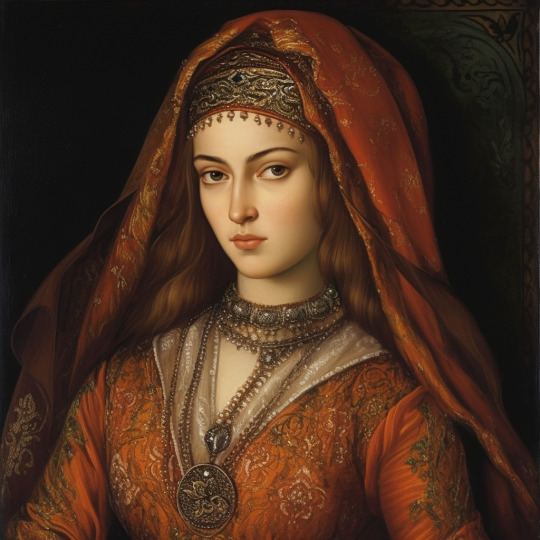
youtube
7 notes
·
View notes
Text
Hümaşah - disambiguation
There are 3 Magnificent Century and Magnificent Century: Kösem characters named Hümaşah and there is 1 bonus historical figure who was left out of the series but would have been named Hümaşah.
Ayşe Hümaşah Sultan was the daughter of Mihrimah Sultan and Rüstem Paşa. She was the granddaughter of Sultan Süleyman and Hürrem Sultan.
Hümaşah Sultan was the daughter of Safiye Sultan and Sultan Murad III and the sister of Sultan Mehmet III. She was also the grand daughter of Sultan Selim II and Nurbanu Sultan and the great-granddaughter of Sultan Süleyman and Hürrem Sultan.
Telli Haseki Hümaşah Sultan was the wife of Sultan İbrahim and the mother of Şehzade Orhan. She was Kösem Sultan’s daughter-in-law.
The historical Şehzade Mehmet (the son of Süleyman and Hürrem) had a daughter named Hümaşah Sultan. When he died in the show, his favourite Cihan Hatun was pregnant with a child. We never see her again or the child. But it’s reasonable to assume that their child would have been Hümaşah Sultan.
#magnificent century#magnificent century: kösem#el sultán#kosem la sultana#muhteşem yüzyıl#muhteşem yüzyıl: kösem
9 notes
·
View notes
Note
hello! Hope you are doing well! I have seen in your post somewhere that Mihrimah"s daughter is accorded "Sultan" title by Suleiman himself. Is there any documentary evidence of it? Thanks!
Well, yes, as Süleyman was the only one who could accord titles.
The documentary evidence is in the Vakıflar Genel Müdürlüğü Arşivi (the Foundations Archive) where Ayşe Hümaşah is listed as Ayşe Sultan in relation to her foundations, I guess. In harem registers, she was listed as Ayşe Sultan as well.
14 notes
·
View notes
Text
Portrait of Mihrimah Sultan/Mihrimah szultána portréja
Mihrimah was the most influential true-born sultana ever: she had the highest salary; she was a worthy child and descendant of her mother; she was a true charitable person who also had enormous political influence; her father’s partner and counselor for a lifetime; the only sibling ever to be an (unofficial) valide sultan to her brother; the "greatest princess" and matriarch of a dynasty ... She was a legendary persona, a unique princess.
Origin and early years
There is an amazing legend about the birth of Mihrimah Sultan. According to this, she was born on 21 March 1522, and for this reason the two mosques - built for her years later, designed by Mimar Sinan - were created so that on the princess's birthday, when the sun goes down behind the minaret of the Mihrimah Mosque in Edirnekapı, the moon just goes up between the two minarets of the other Mihrimah Mosque. An important part of the legend is that Mimar Sinan once had the opportunity to see the sultana and immediately fell in love for her. For this reason, his works of outstanding beauty and precision, the Mihrimah Mosques, are also seen as the embodiment of platonic love.
The legend is beautiful, but unfortunately not real. Mihrimah's brother, Mehmed, was born around October 1521, so Mihrimah could not be born in March 1522. Unfortunately, we do not have any evidence to know exactly when she was born. The discrepancies between the Islamic calendar and our calendar used today make it even more difficult to pinpoint. Most likely, in any case, she was born after August 1522, but definitely before 1523.
Although the date of her birth was unknown, the fact of her birth itself was distinctly extraordinary. According to tradition, if a concubine had given birth to a son, she could not return to the sultan's bed, so basically Hürrem, after giving birth to a son in the autumn of 1521, could no longer have been Sultan Suleiman's sexual partner. However, Hürrem not only returned to Suleiman’s bed, but became the sultan’s exclusive sexual partner and, after Mihrimah, she gave birth to four more children for the sultan. Hürrem had Mihrimah as her only daughter, while Suleiman already had a daughter, Raziye, who, however, died in an epidemic before Mihrimah was even born.
Mihrimah, as the only living little princess, was certainly not only the apple of her father's eye, but the light of the whole harem. She spent most of her time with her mother and governess, but they certainly also had regular contact with her family-centric grandmother, Hafsa. It was probably by this time that she began to learn the basics of embroidery from her mother. Hürrem was particularly talented in embroidery, her works being so outstanding that she sometimes sent them as gifts to the leaders of other dynasties. And Mihrimah was reportedly a great student to her mother, who mastered the technique well. In addition to her mother, her father also played an important role in her childhood. Suleiman often visited his family at the Old Palace, and from 1534 they moved together at the Topkapi Palace. From then on, Mihrimah could spend even more time near her father, whom she had regularly mesmerized with her mere existence.

Marriage and husband candidates
The marriage of imperial princesses has always been an important political tool. However, Suleiman did not make much use of this opportunity. His sisters were even married off by their father, Selim I, and after their widowhood he did not force them to marry again. He had a big amount of respect and love for the female members of his family, so he was expected to treat his daughter the same way. Suleiman, however, not only did not marry off his sisters again and again because of his kind nature, but fortunately he did not need allies what marriages could have given him. The empire was rising, the nation had never been so strong, and everyone loved him as a sultan, so simply he did not need allies by marriages.
Ttherefore, there was no particularly urgent need to marry off Mihrimah and it was not necessary to choose the future husband from among the senior and influental pashas. Thus, Suleiman could easily search for a statesman he liked, even from a lower position. Suleiman wanted a reliable, faithful husband for Mihrimah, while Hürrem would prefer a young and handsome husband. Hürrem recommended the Egyptian beylerbey to Suleiman, who was notoriously handsome and young. However, the sultan did not like the man, as he had a reputation as a womanizer, and it was rumoured that he had syphilis. Of course, many such rumors spread unfoundedly, but Suleiman did not investigate the Egyptian beylerbey, he simply rejected the idea. He had other plans. He singled out a particularly humble and trustworthy guy, who he had long known for, to Mihrimah’s side. His choosen one, Rüstem, was his personal servant for almost 10 years from 1526, after which he served as a governor for the sultan in various provinces of the empire. They were very close to each other, and Rüstem also taught the brothers of Mihrimah for a while, so the princes were well known by him. In addition, it is also likely that Mihrimah also had the opportunity to meet the pasha before, as he may have been in the same place as the sultana because of his proximity to the sultan. Eventually, of course, Hürrem was also accepted Suleiman’s husband candidate and the only question was whether Mihrimah would accept him.
Rüstem was roughly seventeen or twenty years older than Mihrimah, one of the ambassadors reported that he was not a particularly handsome guy, but was short and red-faced. So he was clearly not a teenage girl's dream, even if most sultanas had to marry much older pashas than Rüstem. Yet Mihrimah agreed to the marriage. The question arises, could she have said no at all? As a matter of fact, probably yes. She was Suleiman's favorite child, apple of his eyes, if she would had a personal and deep resentments towards Rüstem, she could have said no. But she didn't. Mihrimah was a very smart woman who stood by her mother's side since her childhood and who probably tryed to help her. She was obviously aware of the law of fratricide, that they had to do everything they could to remove Mustafa — his eldest half-brother — from their way, and with this, saving the lives of her blood-brothers. And Rüstem was a great opportunity to do so, as he had known and loved the sons of Hürrem since childhood, thus there was no question that he would side with Hürrem and Mihrimah in this bloody war. So for the sake of her brother's future, Mihrimah said yes to marriage.

Marriage and relationship with her husband
The wedding took place in 1539. Rüstem could have been around 35 at the time, while Mihrimah was 17 years old. The circumcision ceremony of Bayezid and Cihangir was held at the same time as the wedding of Mihrimah. The double ceremony eventually lasted for 15 days, during which the entire population of Istanbul shared the joy of the Sultan’s family during the festivals and feasts. Due to his position, Rüstem lived in Istanbul, so Mihrimah did not have to move far away from her parents either. That’s why Rüstem was a great choice, as neither Suleiman nor Hürrem wanted to lose their daughter. And Mihrimah, with her strong will, would certainly have manage to stay in the capital as well.
There is no question that it was not a love marriage, however, the relationship was by no means as bad as it was portrayed in the popular series. Mihrimah could at least marry a man he knew, who was a committed supporter of her brothers and was extremely loyal to her father, the Sultan. Their marriage was crowned in 1541 by the birth of their first child. Ayşe Hümaşah was the first child of Rüstem, the first grandson of Hürrem. By now, Suleiman was grandfather of at least one, as Prince Mustafa had a six-year-old daughter, but later Ayşe Hümaşah became his favorite grandchild. Mihrimah and Rüstem later — it is not known exactly when — had another child, a son, Osman. This suggests that they may have had a relatively balanced relationship, as the sultanas could have refused to have sexual intercourse with their husbands. Their fair relationship is also indicated by the fact that they had many charitable projects managed together.
The marriage of the two ended in 1561, with the death of Rüstem Pasha. However, their mutual respect is shown in the will of Rüstem. He left everything to his wife and daughter: the management of his charities was largely given to his daughter, but Mihrimah was given much similar tasks also. In addition, it was Mihrimah who completed the Rüstem Pasha Mosque, which was only half-finished at the time of Rüstem's death.
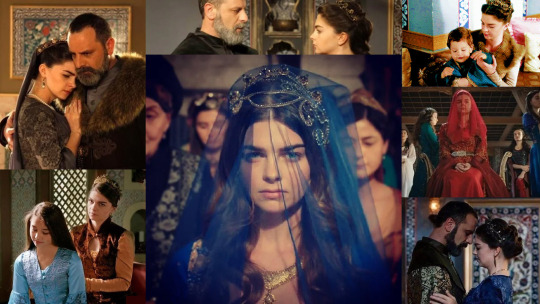
Her intrigues
According to legend, Mihrimah, with the support of her mother Hürrem, wanted to make Rüstem the next Grand Vizier, which plan was finally successfully completed. However, it would be wrong to think that only the actions of the two women led to the appointment of Rüstem. Rüstem had been the sultan's confidential man for twenty years so far, Suleiman found him worthy to be the husband of his only daughter, it was clear that the sultan himself wanted to give this position to Rüstem once. However, Mihrimah and Hürrem were not satisfied with this, but wanted Rüstem to enjoy the prerogatives that Ibrahim had previously enjoyed. The sultan, on the other hand, sharply refrained from letting anyone as close to him as he had done with Ibrahim.
One of the important cornerstones of Mihrimah and Rustem’s marriage was the multitude of common intrigues. Mihrimah was very active politically, with her husband she often was able to uccessfully convince the sultan. This was the case when, in 1542, Suleiman wanted to take the infant Hungarian king and his mother, Queen Isabella, to Istanbul as political prisoners. However, being a smart woman, Izabella knew she could get help from the sultan's daughter and wife. So she complained to Mihrimah and Hürrem about how young she was widowed, how she was left alone with her son and now even the sultan want to deprived her and her son of their throne. In addition, of course, she also sent very valuable gifts to Mihrimah and her husband. She must have mentioned her descent in her letter as well. Izabella was the daughter of the King of Poland, from whose country Hürrem Sultan came from. And this was an important link between Hürrem, Mihrimah and Izabella. Either way, Izabella persuaded Hürrem and Mihrimah, who together with Rüstem, easily persuaded the Sultan to support Izabella and her son instead of bringing them to Istanbul as prisoners. Thus it happened that János Zsigmond Szapolyai became the next king of Hungary.
However, the main task of the couple was to support the brothers of Mihrimah, especially Prince Mehmed. By 1543 it was quite clear that they wanted Mehmed to ascend the throne and the trio had done all they could for this aim. However, the early death of the prince made their situation more difficult. For a time they did not care which prince of theirs should be the next sultan, they worked only and exclusively to get rid of Prince Mustafa. It took another ten years before they were finally successful and Mustafa was executed by the Sultan. Exactly how much Mihrimah was involved in this process and what she did is unknown, as there is no evidence at all to prove the guilt of Hürrem or Mihrimah. But nonetheless, it would be naive to think that Mihrimah, who was the copy of her mother both in body and soul, would not have been involved in the struggle of her beloved mother and husband.
It seems that after Mustafa's death, the trio voted for Prince Bayezid, while the Sultan himself favored Selim. Perhaps that is why Bayezid was chosen: to balance the situation of the two princes. However, Bayezid’s nature resembled a timed bomb, so they were afraid that if he was not supported, he would raise the Sultan’s anger with a reckless act. Thus, the fact that Bayezid was supported does not clearly mean that they also wanted him to be the one sitting on the throne.

Loss of her mother
1558 brought a drastic change in Mihrimah's life. Hürrem Sultan died. Mihrimah and her mother were especially close to each other, of the known mother-daughter relationships, the two of them had the closest. Mihrimah visited Hürrem every day at Topkapi Palace, spending more time there than in her own palace. She also regularly accompanied her mother on her travels and visited her siblings together. Thus, the loss of Hürrem was certainly a great pain for Mihrimah. However, Hürrem, at the time of her death, handed over her responsibilities to her daughter, who thus had no time to mourn, she had to take immediate action to continue her mother's path. And this meant nothing more than the support of the Sultan and the protection of Prince Bayezid.
However, Mihrimah could not influence Bayezid like their mother, so she could not meke the prince to wait patiently and not annoy the sultan. Bayezid soon revolted against the sultan, and for this, according to several sources, Bayezid asked Mihrimah for money. And Mihrimah gave it to him. When the sultan realized this, he immediately questioned his daughter, who proudly replied that her mother asked her to do anything for Bayezid on her deathbed, so she was not guilty of anything. We don’t know how Suleiman reacted, but their relationship seems to have deteriorated for a while.
However, Mihrimah's support was not enough either, Bayezid failed in the decisive battle of the rebellion he fought, lost the battle and was forced to flee the battlefield. By this time, both Mihrimah and Rustem were helpless. And Rustem soon lost his life, so there was no one left to save Bayezid and his sons from execution. Bayezid was executed in 1562, and a few months later the sultan organized a huge wedding to marry off the daughters of the heir, Prince Selim, one of the daughters of the late Prince Mustafa, and the daughter of Bayezid who was at the appropriate age for marriage. Mihrimah faced her father again because of the wedding. Most sources say that it was only during the wedding preparations that Mihrimah learned that Bayezid had been executed, as by then the news had not reached Istanbul and Suleiman had ordered complete secrecy. Mihrimah, shattered and enraged by grief, found it deeply outrageous that a ceremony was being held in the empire shortly after his brother was executed. Therefore, she tried in every way possible to make the ceremony impossible, for example by forbidding anyone in the harem to have fun and show happiness. Since Mihrimah lived in the Old Palace since the death of Rustem and she probably led the harem also, her orders were accepted and there was no amusement in the harem. According to reports from the ambassadors, Suleiman was shattered and disappointed. However, upon hearing the news, Selim allegedly said, angrily, that he never loved his sister, nor her husband, nor their mother, for choosing Bayezid instead. However, the reliability of this news is in doubt, for the ambassador who wrote it deeply despised Selim.
Her relationship with her father seems to have settled over time, however, since in 1565, for example, Mihrimah persuaded her father to initiate a campaign against Malta, and she herself offered her own treasury, teasing to exhibit 400 galleys to the army. Thus, although there is no doubt that the execution of Bayezid left its mark on their relationship forever. It was probably at the end of his life that Suleiman could have his only daughter with him again.
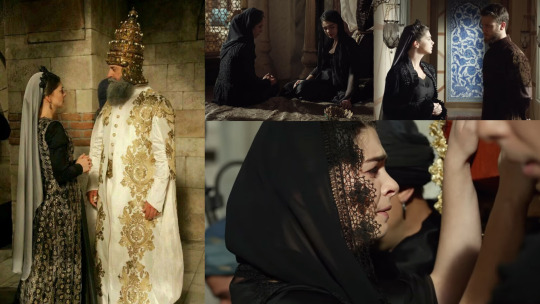
The new era
Mihrimah lost her father in 1566 and a new world began for her with the reign of her younger brother, Selim. The relationship between the two was not the best, as Mihrimah was always on Bayezid’s side, but by this time only the two of them were alive from the family, so they chose togetherness instead of hatred. First, Mihrimah extended a helping hand to Selim when he was blackmailed and humiliated by the Janissaries before his accession to the throne. The Janissaries wanted to get their ascension fee immediately when Selim had not even ascended the throne. At that time, Selim did not have access to the imperial treasury, and it would have been too long to bring money from his own province, so Mihrimah paid the soldier's allowance for Selim to occupy the throne at all without riots. Selim did not remain ungrateful, for he made his sister the head of the Old Palace harem, and thus a de facto valide sultan.
During Selim's reign, she basically stayed in the background and spent her time on charity, construction projects instead of politics. Mihrimah has supported many construction projects, but the most famous are undoubtedly the two Mihrimah mosques, which are the most beautiful works of the imperial architect Mimar Sinan. She also supported Nurbanu's efforts to free two captured Turkish women from the French. Together, with Nurbanu’s daughters and her own daughter, they finally persuaded the Queen of France to send the women back home. Based on this, we can think that she had a good relationship with Nurbanu. There is no direct evidence of a relationship between the two women, probably it was a respectful one. However, Mihrimah’s daughter supported Nurbanu’s opponent, Safiye Haseki Sultan, which also raises the possibility that Mihrimah herself favored Safiye over Nurbanu.
The twilight of her life
Selim died in 1574 and his son Murad succeeded him to the throne. The relationship between Murad and Mihrimah is not known, but presumably a spike could have remained in Murad for Mihrimah supporting Bayezid. That is why there are those who suspect that Mihrimah lost all power during Murad's reign. In fact, this is unlikely, as Murad gave Mihrimah a salary as high as no other imperial princess has ever received in a similar situation. Mihrimah may have decided to retire by herself. With the death of Selim, she was left alone in the family, having so far lost four brothers, both parents, nephews, husband and her own son. Broken with so much pain, she probably no longer felt the urge to care with politics. Her daughter Ayşe Hümaşah, who was very active politically, continued her path.
Mihrimah died on 25 January 1578, in the Old Palace. Sultan Murad decided to bury Mihrimah next to her father, breaking the tradition that the sultans rested alone in their turbe. However, with her death, her bloodline did not disappear, as her daughter, her descendants, could be traced back to the 20th century, but presumably other family members still live today. They are the Mihrumazadelers.

Used sources: L. Peirce - Empress of the east; L. Peirce - The imperial harem; Y. Öztuna - Kanuni Sultan Süleyman; N. Sakaoğlu - Bu Mülkün Kadın Sultanları
* * *
Mihrimah volt a valaha élt legbefolyásosabb birodalmi szultána: övé volt a legmagasabb fizetés; méltó gyermeke és utódja volt édesanyjának; igazi jótékony személy volt, hatalmas politikai befolyással; apja társa és tanácsadója egy életen át; az egyetlen valaha volt testvér, aki nem hivatalos valide szultána lehetett öccse mellett; a "legnagyobb hercegnő" és egy dinasztia matriarchája... Egy legendás személyiség volt, soha hozzá fogható nem élt.
Származása és korai évei
Mihrimah szultána születését egy igen érdekes legenda övezi. Eszerint 1522 március 21-én született, és ezen okból kifolyólag az évekkel később neki építtetett két mecsetet Mimar Sinan, birodalmi főépítész úgy tervezte meg, hogy a hercegnő születésnapján, amikor a nap az Edirnekapıban található Mihrimah-mecset minaretje mögött lemegy, a hold az üsküdari Mihrimah-mecset két tornya között éppen akkor keljen fel. A legenda fontos része az is, hogy Mimar Sinannak egyszer alkalma nyílt meglesni a szultánát és azonnal beleszeretett. Éppen ezért, a kiemelkedő szépségű és precizitású munkáit, a Mihrimah-mecseteket a plátói szerelem megtestesüléseként is tekintik.
A legenda gyönyörű, azonban sajnos nem valós. Mihrimah bátyja, Mehmed 1521 októbere körül született, így Mihrimah matematikailag nem születhetett 1522 márciusában. Sajnos nem áll rendelkezésünkre semmi olyan bizonyíték, amely alátámasztaná, hogy pontosan mikor született a szultána. Az iszlám naptár és a ma használt naptárunk közötti eltérések tovább nehezítik a pontos meghatározást. A legvalószínűbb mindenesetre, hogy 1522 augusztusa, szeptembere körül születhetett leghamarabb, de mindenképpen 1523 előtt.
Születési ideje bár nem ismert, születésének ténye maga kifejezetten rendkívüli volt. A tradíciók szerint ha egy ágyas fiút szült, nem térhetett vissza a szultán ágyába, így elméletileg Hürrem, miután 1521 őszén fiút szült, nem lehetett volna tovább Szulejmán szultán szexuális partnere. Hürrem azonban nem csak visszatért Szulejmán ágyába, de a szultán kizárólagos szexuális partnere lett és Mihrimah után további négy gyermeket szült a szultánnak. Hürremnek Mihrimah volt az egyetlen leánygyermeke, míg Szulejmánnak volt már egy kislánya, Raziye, aki azonban Mihrimah születése előtt életét vesztette egy járvány során.
Mihrimah, mint az egyetlen élő kishercegnő minden bizonnyal nem csak édesapja, de az egész hárem szeme fénye volt. Ideje nagyrészét édesanyjával és dajkájával töltötte, ám emellett minden bizonnyal a családcentrikus nagyanyjával is rendszeres kapcsolatban álltak. Valószínűleg már ekkor elkezdte eltanulni édesanyjától a hímzés alapjait. Hürrem ugyanis különösen tehtséges volt a hímzésben, munkái olyan kiemelkedő szépségűek voltak, hogy előfordult, hogy más dinasztia fejeinek küldte őket ajándékba. Mihrimah pedig a beszámolók szerint remek diákja volt anyjának, aki remekül elsajátította a technikát. Édesanyja mellett, apja is fontos szerepet töltött be már gyermekkorában. Szulejmán gyakran látogatta családját a Régi Palotában, majd 1534-től összeköltöztek a Topkapi Palotában. Innentől kezdve Mihrimah még több időt tölthetett édesapja közelében, akit már puszta létezésével is rendszeresen levett a lábáról.

Kiházasítása és a férjjelöltek
A birodalmi hercegnők házassága mindig fontos politikai eszköz volt. Szulejmán azonban nem különösebben élt ezzel a lehetőséggel. Lánytestvéreit is még apjuk, I. Szelim házasította ki, megözvegyülésük után ő pedig nem forszírozta újra házasodásukat. Meglehetősen nagy tisztelettel és szeretettel viseltetett családja nőtagjai iránt, így várható volt, hogy egyetlen kislányával szemben is a rá jellemző alapossággal fog eljárni. Szulejmán azonban nem csak kedves természete miatt nem használta ki nőrokonait, hanem szerencséjére nem volt szüksége szövetségesekre, melyeket a házasságok jeenthettek volna neki, hiszen a birodalom szárnyalt, sose volt még ilyen erős a nemzet és őt magát is mindenki szerette.
Ilyen háttérrel tehát nem volt kifejezetten sürgős Mihrimah kiházasítása és nem volt szükséges magas beosztású pasák közül választani a férjjelöltet. Így Szulejmán nyugodtan kereshetett neki tetsző államférfit, akár alacsonyabb pozícióból is. Szulejmán megbízható, hűséges férjet akart Mihrimah számára, ezzel szemben Hürrem inkább fiatal és jóképű férjet. Hürrem az egyiptomi beglerbéget ajánlotta Szulejmánnak, aki köztudottan jóképű és ifjú volt. A szultánnak azonban nem volt kedvére a férfi, hiszen csapodár természet hírében állt, ráadásul azt terjesztették róla, hogy szifilisze van. Természetesen sok ilyen pletyka terjengett alaptalanul is, Szulejmán azonban nem vizsgáltatta ki az egyiptomi beglerbéget, egyszerűen csak elvetette az ötletet. Neki ugyanis más tervei voltak. Egy általa régóta ismert, különösen szerény és megbízható pasát szemelt ki Mihrimah oldalára. Kiszemeltje, Rüsztem pasa 1526-tól majdnem 10 évig a személyes szolgálója volt, utána pedig feltörekvő pasaként szolgálta a szultánt a birodalom különböző tartományaiban. Igen közel álltak egymáshoz, valamint Rüsztem Mihrimah testvéreit is oktatta egy ideig, így a hercegek is jól ismerték. Emellett az is valószínű, hogy Mihrimahnak is volt alkalma találkozni a pasával, hiszen az kifejezetten sok helyen ott lehetett a szultánhoz való közelsége miatt, ahol lehetősége volt látni a szultánát. Végül természetesen Hürrem is kénytelen volt elfogadni Szulejmán férjjelöltjét és már csak az volt a kérdés, hogy Mihrimah elfogadja e.
Rüsztem nagyjából tizenhét-húsz évvel volt idősebb Mihrimahnál, az egyik követ beszámolója szerint nem kifejezetten jóképű, alacsony és vörös képű férfi volt. Egyértelműen nem egy kamaszlány vágyálma volt tehát, még akkor sem ha a legtöbb szultána jóval idősebb férjet kapott maga mellé. Mihrimah mégis beleegyezett a házasságba. Felmerül a kérdés, hogy mondhatott volna egyáltalán nemet? Ami azt illeti valószínűleg igen. Ő volt Szulejmán kedvenc gyermeke, szemefénye, ha különös és mély ellenérzései lettek volna Rüsztem irányába, mondhatott volna nemet. Ám ő nem tette. Mihrimah igen okos nő volt, aki gyermekkorától kezdve édesanyja oldalán állt és valószínűleg próbálta őt segíteni. Nyilvánvalóan tisztában volt a testvérgyilkosság törvényével, azzal, hogy mindent meg kell tenniük, hogy Musztafát - legidősebb féltestvérét - eltávolítsák az útból, ezzel megmentve édestestvérei életét. Rüsztem pedig nagyszerű lehetőség volt erre, hiszen gyermekkoruktól kezdve ismerte és szerette Hürrem fiait, nem volt kérdéses, hogy Hürrem és Mihrimah oldalára fog állni ebben a vérremenő harcban. Így tehát testvérei jövője érdekében Mihrimah igent mondott a házasságra.

Házassága és viszonya férjével
Az esküvőre végül 1539-ben került sor. Rüsztem 35 körül lehetett ekkor, míg Mihrimah 17 éves volt. Hogy minél nagyobb ünnepséget kerekítsenek belőle, az esküvővel egy időben megtartották Bayezid és Cihangir herceg körülmetélési szertartását is. A dupla-ünnepség végül 15 napig tartott, melynek során Isztambul teljes lakossága osztozott a szultáni család örömében a fesztiválok és lakomák során. Rüsztem pozíciójának köszönhetően Isztambulban élt, így Mihrimahnak sem kellett szüleitől távol költözni. Rüsztem ezért is volt nagyszerű választás, hiszen sem Szulejmán, sem Hürrem nem akarta lányát elveszíteni. Mihrimah pedig erős akaratával minden bizonnyal szintén azon ügyködött volna, hogy a fővárosban maradhasson.
Nem kérdés, hogy nem szerelmi házasság köttetett, azonban a viszony korántsem volt olyan rossz, ahogy például a népszerű sorozatban ábrázolták. Mihrimah legalább olyan emberhez mehetett feleségül, akit ismert, aki elkötelezett támogatója volt testvéreinek és végletekig hűséges volt apjához, a szultánhoz. Házasságukat első gyermekük születése koronázta meg 1541-ben. Ayşe Hümaşah volt Rüsztem első gyermeke, Hürrem első unokája. Szulejmán eddigre már legalább egyszeres nagyapa volt, Musztafa hercegnek ugyanis volt már egy hat éves kislánya, azonban mégis később Ayşe Hümaşah lett kedvenc unokája. Mihrimah és Rüsztem kapcsolatából később - nem pontosan ismert mikor - született egy fiú is, Osman. Ez azt sugallja, hogy viszonylag kiegyensúlyozott kapcsolatuk lehetett, hiszen a szultánák megtagadhatták a szexuális együttlétet férjükkel. Erre utal az a tény is, hogy nagyon sok jótékony projektet közösen irányítottak.
Kettejük házassága 1561-ben, Rüsztem Pasa halálával ért véget. Kölcsönös tiszteletüket mutatja azonban Rüsztem végrendelete. Mindenét feleségére és lányára hagyta: jótékonysági szervezeteinek irányítását nagyrészt lányára, ám Mihrimahnak is jócskán jutott hasonló feladat. Emellett Mihrimah volt az, aki befejezte Rüsztem Pasa mecsetjét, amely Rüsztem halálakor még csak félkész állapotban volt.

Az intrikus szultána
A legendák szerint Mihrimah, édesanyja Hürrem támogatásával szerette volna elérni, hogy Rüsztem legyen a következő nagyvezír, mely tervüket végül sikerrel véghezvitték. Azonban téves lenne azt gondolni, hogy csak a két nő ténykedése vezetett Rüsztem kinevezéséhez. Rüsztem eddigre húsz éve volt a szultán bizalmas embere, Szulejmán méltónak találta őt egyetlen lánya kezére, egyértelmű volt, hogy a szultán maga is ezt a pozíciót egyszer Rüsztemnek akarta adni. Mihrimah és Hürrem azonban ezzel nem elégedtek meg, hanem olyan előjogokat akartak Rüsztemnek, amelyek korábban Ibrahim Pasát is megillették. A szultán viszont élesen elzárkózott attól, hogy bárkit újra olyan közel engedjen magához, mint ahogyan Ibrahimmal tette.
Mihrimah és Rüsztem házasságának egyik fontos alapköve volt a közös intrikák sokasága. Mihrimah politikailag igen aktív volt, sokszor férjével közösen sikerrel győzték meg a szultánt egy egy ügy kapcsán. Ilyen volt, amikor 1542-ben Szulejmán szerette volna Isztambulba vitetni politikai fogolyként a csecsemő magyar királyt és édesanyját, Izabella királynét. Izabella azonban okos nő lévén tudta, hogy segítséget kaphat a szultán lányától és nejétől. Elpanaszolta hát helyzetét Mihrimahnak és Hürremnek is: hogy milyen ifjan megözvegyült, egyedül maradt fiával és most még trónjától, jogától is megfosztanák. Emellett pedig természetesen igen értékes ajándékokat is küldött Mihrimah szultána és férje számára. Minden bizonnyal Izabella levelében kijátszotta származását is. Izabella ugyanis a lengyel király lánya volt, azé a lengyel királyé, akinek országából Hürrem szultána származott. Ez pedig fontos kapocs volt Hürrem, Mihrimah és Izabella között. Akárhogyan is, Izabella meggyőzte Hürremet és Mihrimaht is, akik Rüsztemmel karöltve könnyedén rávették a szultánt, hogy támogassa Izabellát és annak fiát, ahelyett, hogy fogolyként Isztambulba hozatná őket. Így lett hát, hogy Szapolyai János Zsigmond lett a Magyar Királyság következő királya.
A házaspár fő feladata azonban Mihrimah testvéreinek támogatása volt, különösen Mehmed hercegé. 1543-ig teljesen egyértelmű volt, hogy Mehmed herceget szerették volna trónra emelni és a trió ehhez mindent elkövetett. A herceg korai halála azonban megnehezítette helyzetüket. Egy ideig nem foglalkoztak azzal, hogy melyik herceg legyen az új kiszemeltjük, csak és kizárólag Musztafa herceg ellehetetlenítésén dolgoztak. Még tíz évbe telt, mire végül sikerrel jártak és Musztafát kivégeztette a szultán. Az, hogy Mihrimah pontosan mennyire és hogyan vett részt ebben a folyamatban, nem ismert, hiszen nincsenek egyáltalán olyan bizonyítékok, amelyek Hürrem vagy Mihrimah bűnösségét bizonyítanák. Ám ettől függetlenül naivitás lenne azt gondolnunk, hogy Mihrimah, aki anyja kiköpött mása volt testben és lélekben is, nem vett volna részt szeretett anyja és férje harcában.
Olybá tűnik, hogy Musztafa halála után a trió Bayezid herceg mellett tette le a voksát, míg a szultán maga Szelimet favorizálta. Talán épp ezért választották Bayezidet, hogy kiegyenlített lehessen a két herceg helyzete. Mindemellett Bayezid természete egy időzített bombához hasonlított, így félő volt, ha nem támogatják, a szultán haragját fogja kivívni egy meggondolatlan cselekedettel. Így az, hogy Bayezidet támogatták, nem jelenti egyértelműen azt, hogy a trónon is őt szerették volna látni.

Édesanyja elvesztése
1558 drasztikus változást hozott Mihrimah életében. Hürrem szultána meghalt. Mihrimah és édesanyja különösen közel álltak egymáshoz, az ismert anya-lánya kapcsolatok közül, kettejüké volt a legszorosabb. Mihrimah minden nap meglátogatta Hürremet a Topkapi Palotában, ezzel pedig több időt töltött ott, mint saját palotájában. Emellett rendszeresen elkísérte anyját annak utazásaira és együtt látogatták meg testvéreit. Így minden bizonnyal Hürrem elvesztése hatalmas fájdalmat jelentett Mihrimah számára. Azonban Hürrem, halálakor feladatait lányára ruházta át, akinek így nem volt ideje gyászolni, azonnal akcióba kellett lépnie, hogy folytathassa édesanyja útját. Ez pedig nem jelentett mást, mint a szultán támogatását és Bayezid herceg védelmét.
Mihrimah azonban nem tudta úgy befolyásolni Bayezidet, mint édesanyjuk, így nem tudta azt sem elérni, hogy a herceg türelemmel várjon és ne bosszantsa a szultánt. Bayezid hamarosan fellázadt a szultán ellen, mely lázadáshoz több forrás szerint is Mihrimahtól kért pénzt. Mihrimah pedig adott neki. A szultán mikor rájött erre, azonnal kérdőre vonta lányát, aki annyit felelt, hogy édesanyja végakaratát teljesítette, ezért ő nem bűnös semmiben. Nem tudjuk, hogy Szulejmán hogyan reagált, de úgy tűnik viszonyuk egy időre megromlott.
Azonban Mihrimah támogatása sem volt elég, Bayezid herceg az általa szított lázadás döntő ütközetében elbukott, elvesztette a csatát és kénytelen volt elmenkülni a harctérről. Ekkor már Mihrimah és Rüsztem is tehetetlenek voltak. Rüsztem pasa pedig hamarosan életét vesztette, így nem maradt senki, aki meg menthette volna Bayezidet és fiait a kivégzéstől. 1562-ben Bayezidet kivégezték, majd néhány hónapra rá a szultán hatalmas lakodalmat szervezett, hogy kiházasítsa az örökös, Szelim herceg lányait, az elhunyt Musztafa herceg egyik lányát és Bayezid megfelelő korban lévő lányát is. Mihrimah újra szembekerült apjával az esküvő miatt. A források legtöbbje úgy írja, hogy Mihrimah csak az esküvő előkészületei során tudta meg, hogy Bayezidet kivégezték, addigra ugyanis a hírek nem érték el Isztambult, Szulejmán pedig teljes titoktartást rendelt el. Mihrimah a gyásztól ��sszetörve és feldühödve mélységesen felháborítónak tartotta, hogy nemsokkal a testvére kivégzése után ünnepséget rendeznek a birodalomban. Ezért minden lehetséges módon igyekezett ellehetetleníteni a szertartást, így például megtiltotta, hogy a háremben bárki is mulatozzon és boldogságot mutasson. Mivel Mihrimah Rüsztem halála óta a Régi Palotában élt és valószínűleg vezette is azt, parancsai célt értek és a háremben elmaradt a mulatság. A követek beszámolói alapján Szulejmán összetört, és mérhetetlenül csalódott volt. Szelim azonban a hír hallatán állítólag feldühödve kijelentette, hogy sosem szerette nővérét, sem annak férjét sőt anyjukat sem, amiért azok Bayezidet választották helyette. Ezen hír megbízhatósága azonban kétséges, ugyanis a követ aki ezt lejegyezte mélységesen megvetette Szelim herceget.
Viszonya apjával úgy tűnik idővel mégis rendeződött, hiszen 1565-ben például Mihrimah győzködte apját, hogy kezdeményezzen hadjáratot Málta ellen, ő maga pedig saját kincstárát is felajánlotta, megígrve, hogy kiállít 400 gályát a hadsereg számára. Így tehát - bár kétségtelen hogy Bayezid kivégzése örökre nyomot hagyott kapcsolatukon - valószínűleg élete végén Szulejmán újra maga mellett tudhatta egyetlen lányát.

Az új korszak
Mihrimah 1566-ban elveszítette édesapját és egy új világ kezdődött számára öccse, Szelim uralkodásával. A két testvér viszonya nem volt felhőtlen, hiszen Mihrimah mindig Bayezid pártján állt, azonban ekkorra már csak ők ketten voltak életben a családból, ezért az összetartást választották a gyűlölködés helyett. Először Mihrimah nyújtott segítő kezet Szelimnek, amikor azt a janicsárok megzsarolták és megalázták trónralépése előtt. A janicsárok ugyanis azonnal meg akarták kapni a trónralépési jussukat, amikor Szelim még nem is lépett trónra. Ekkor Szelimnek nem volt hozzáférése a birodalmi kincstárhoz, saját tartományából pedig túl hosszú idő lett volna pénzt hozatni, így Mihrimah fizette ki a katonák jussát, hogy Szelim egyáltalán elfoglalhassa a trónt zavargások nélkül. Szelim nem maradt hálátlan, ugyanis nővérét tette meg a Régi Palota fejévé, ezzel pedig de facto valide szultánává.
Szelim uralkodása alatt alapvetően a háttérben maradt és jótékonykodással, építkezési projektekkel töltötte idejét a politika helyett. Mihrimah rengeteg építkezési projektet támogatott, ám leghíresebb kétségkívül a két Mihrimah-mecset, melyek Mimar Sinan birodalmi építész legszebb munkái. Emellett támogatta Nurbanu azon törekvését, hogy a franciáktól visszaszerezzenek két fogjul ejtett török nőt. Közösen, Nurbanu lányaival és saját lányával karöltve végül meggyőzték a francia királynét, hogy küldje haza a nőket. Ez alapján úgy gondolhatjuk, hogy Nurbanuval jó viszonyban voltak. Nincs közvetlen bizonyíték a két nő viszonyára, valószínűleg tiszteletteljes viszony állt fenn köztük. Mihrimah lánya azonban Nurbanu ellenfelét, Safiye Haseki szultánát támogatta, ami felveti azt az eshetőséget is, hogy Mihrimah maga is Safiyét favorizálta Nurbanuval szemben.
Élete alkonya
Szelim 1574-ben elhunyt és fia Murad követte a trónon. Murad és Mihrimah viszonya nem ismert ám feltehetőleg Muradban is maradthatott tüske, amiért Mihrimah Bayezidet támogatta. Épp emiatt vannak akik úgy sejtik, hogy Mihrimah minden hatalmát elvesztette Murad uralkodása alatt. Valójában ez nem valószínű, hiszen Murad olyan magas fizetést adott Mihrimahnak, amilyet soha egyetlen birodalmi hercegnő sem kapott hasonló helyzetben. Mihrimah talán maga döntött úgy, hogy visszavonul. Szelim halálával egyedül maradt a családból, eddigre elveszítette négy testvérét, mindkét szülőjét, unokaöccseit, férjét és saját fiát is. Ennyi fájdalomtól megtörve valószínűleg nem érzett már késztetést, hogy politikával foglalkozzon. Útját lánya Ayşe Hümaşah folytatta, aki politikailag igen aktív volt.
Mihrimah 1578. január 25-én hunyt el a Régi Palotában. Murad szultán úgy döntött, hogy a hagyományokat (miszerint a szultánok egyedül nyugodtak türbéjükben) megtörve, Mihrimah szultánát édesapja mellé temetteti el. Halálával azonban vérvonala nem tűnt el, hiszen lánya által, leszármazottjai a 20. századig nyomonkövethetőek voltak, ám feltehetőleg napjainkban is élnek további cslaádtagok. Ők a Mihrumazadeler-ek.

Felhasznált források: L. Peirce - Empress of the east; L. Peirce - The imperial harem; Y. Öztuna - Kanuni Sultan Süleyman; N. Sakaoğlu - Bu Mülkün Kadın Sultanları
#Mihrimah Sultan#mimar sinan#sultan suleyman#KanuniSultanSüleyman#Suleiman the Magnificent#Suleiman I#Haseki Hürrem Sultan#hürrem sultan#safiye sultan#rustem pasha#rüstem paşa#ayse humasah#ayşe hümaşah#Selim II#Nurbanu Sultan#ayşe hafsa
96 notes
·
View notes
Note
Which historical figures that were not included in MC&MCK you are most upset about?
Hümaşah Sultan, Şehzade Mehmed’s daughter. I’m actually really surprised that she was omitted because she played an important role during her grandfather’s reign & she was the only remainder Hürrem and Suleiman had of their prematurely deceased son, so it’s totally weird they never even mentioned her or the mere fact that she had been born posthomously.
I’m surprised because while they had many characters&events in S4 to cover, but the way they didn’t even mention her existence is puzzling, especially since we saw Mehmed’s concubine at advanced stage of pregnancy during her death? They didn’t do much with Mihrimah’s daughter Ayşe Hümaşah, but at least she existed lol.
Of course I’d really like to see adult Fatma Sultan and Ayşe Sultan (Kösem’s daughters), but here I’m pretty sure we would have got them if they had had the opportunity to film S3, since they were clearly kept for Ibrahim’s reign because we know from sources that they were in capital at that time (because they were reported to be among the ones serving Telli Hümaşah). Here however I understand the omission and also exchanging them for Turhan (wrt to serving Telli thing)… there was no time for new plots, it would have only served to showcase his madness yet again, and it was more important for writers at that moment to deepen the Ibrahim & Turhan conflict for the main plot (and frankly they made Turhan an important haseki, so she would actually be higher in palace hierarchy than sultan’s sisters). And yes at least we were informed they existed and lived with their husbands away from capital, and Kösem also mentioned that Fatma had children.
Possibility of having adult Ayşe and Fatma was automatically gone when they decided to cancel the show, but why they never even mentioned Mehmed’s Hümaşah is really baffling to me.
- Joanna
#magnificent century#muhteşem yüzyıl#magnificent century kosem#muhteşem yüzyıl kösem#ottoman history#answered#history
20 notes
·
View notes
Photo
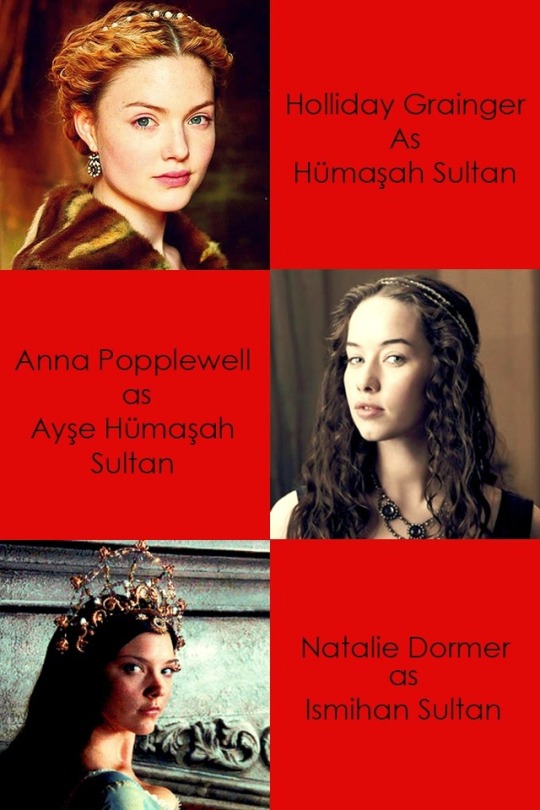

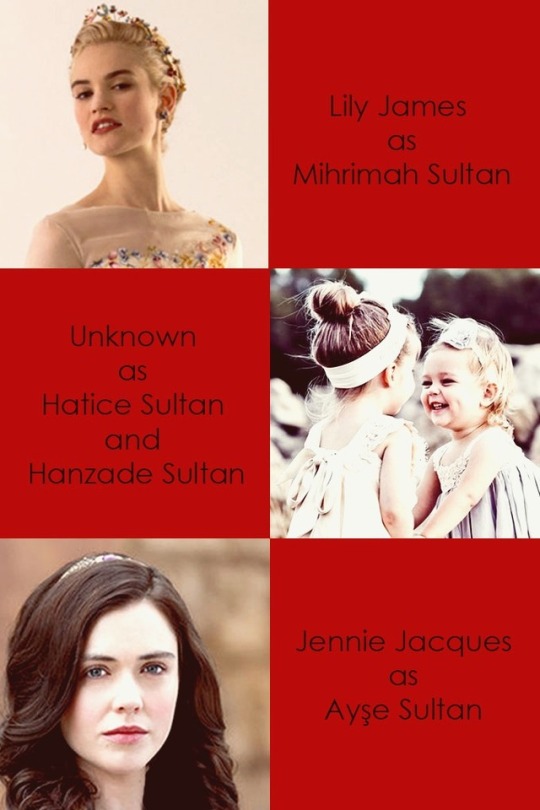
Muhteşem Yüzyıl (Magnificent Century) fancast: Daughters of Hürrem Haseki Sultan. Second generation.
1. Hümaşah Sultan (1540-1593) - daughter of Şehzade Mehmed of the Ottoman Empire.Like her cousin Ayşe Hümaşah Sultan, she was reportedly beloved by their grandfather, to whom she wrote letters.She is regarded amongst the most influential women of Suleiman's reign.This affection can be explained, in large measure, by the fact that her late father, Mehmed, was Suleiman's favorite son. It was she who, in 1563, gifted her cousin Şehzade Murad (future Sultan Murad III) with a concubine that would go on to be Safiye Sultan.
2. Ayşe Hümaşah Sultan (1541–1594) - daughter of Mihrimah Sultan of the Ottoman Empire and Rüstem Pasha. She was her parents' first child and only daughter, and possibly her grandparents' first grandchild as well. She had several brothers, whose number and names are though contested.
3. Ismihan Sultan (1544 – 1585) - daughter of Selim II��and Nurbanu Sultan. She was the most powerful daughter of Selim II because she was married to the Grand Vizier Sokollu Mehmed Pasha. She is famous for having built the Sokollu Mehmed Pasha Mosque and Esmahan Sultan Mosque.
4. Gevherhan Sultan (1544 - after 1604) - daughter of Sultan Selim II and Nurbanu Sultan. Soon after his succession, Mehmed's son by Handan Sultan, Ahmed I wanted to express his gratitude to Mehmed Pasha and Gevherhan Sultan for the role they had played in bringing his parents together. He also named one of his daughters after her.
5. Şah Sultan (1545 – 1580) - daughter of Selim II and Nurbanu Sultan. The union of Şah Sultan to Zal Mahmud is said to be a very happy one. They were suited to each another. It was said that, that they fell ill at the same time, lay in their deathbeds together, and expired at the same very moment.
6. Fatma Sultan (1559–1580) - daughter of Sultan Selim II. Fatma was born in 1559,during Selim's princedom, at Konya or Karaman where he served as sanjakbey, or provincial governor, at the time.
7. Mihrimah Sultan (1547 – 1594) - daughter of Şehzade Bayezid. Married in 1562 to Damat Müzaffer Pasha.
8. Hatice Sultan and Hanzade Sultan (1550/1556-?) - daughters of Şehzade Bayezid.
9. Ayşe Sultan (1553- 1572) - daughter of Şehzade Bayezid. Married in 1562 to Damat Hoca Ali Pasha Eretnaoğlu.
#hurrem sultan#magnificent century#muhteşem yüzyıl#Mihrimah Sultan#nurbanu sultan#sultan suleyman#perioddramaedit
34 notes
·
View notes
Note
From the promo pics the girl in the light blue grayish dress is that the same actress who played mihrimahs daughter in mc?
Hello Anon!
No, it’s not the same actress. Grown-up Ayşe Hümaşah Sultan (Mihrimah’s daughter) was played by Kayra Zabci. The actress who will play Esleme (the girl in light blue-gray dress) is called Leyla Tanlar.
- Joanna
5 notes
·
View notes
Note
hi! may I ask who you used for the little girl in your post here on merogivian history post/631242453788360704?
Hi! She is the cute pumpkin Ayşe Hümaşah Sultan, daughter of Mihrimah Sultan in episode 102.
0 notes
Text
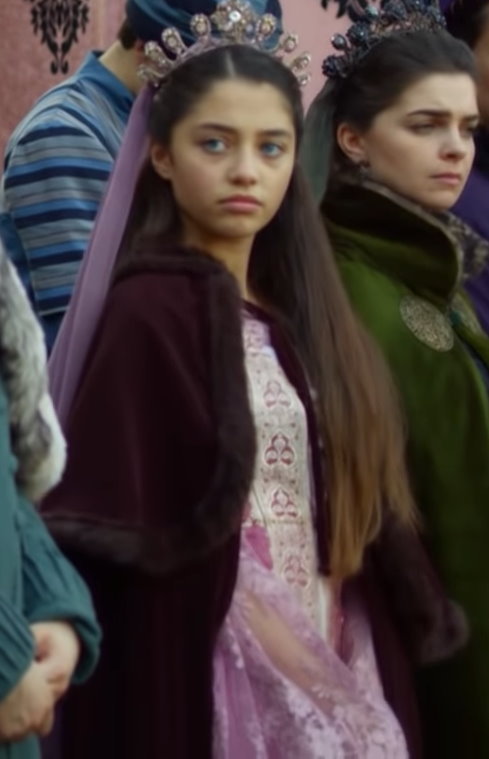
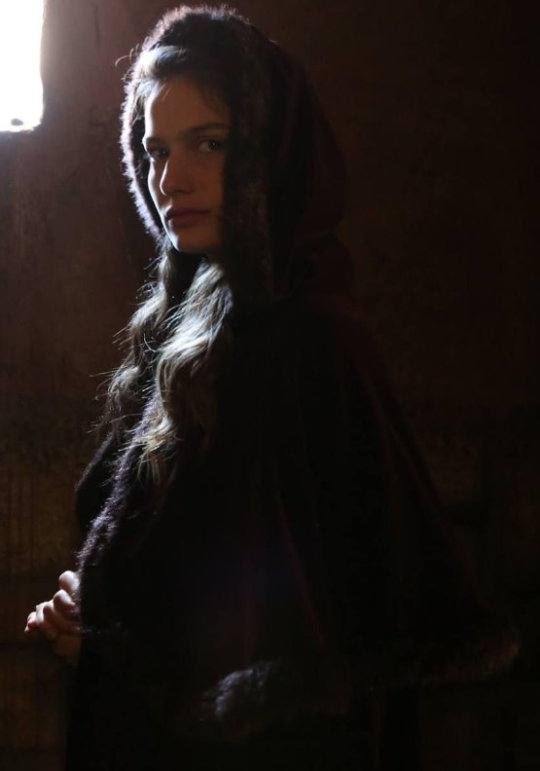
This red cloak with brown fur was first worn by Hümaşah Sultan the twenty-second episode of the fourth season of Magnificent Century.
It appears again on Fahriye Sultan in the tenth episode of the first season of Magnificent Century: Kösem.
#Muhteşem Yüzyıl#Muhteşem Yüzyıl: Kösem#Magnificent Century#Magnificent Century Kösem#Magnificent Century Kosem#period drama#costume drama#historical drama#Hümaşah Sultan#Humasah Sultan#Hümaşah Sultan (Daughter of Mihrimah)#Ayşe Hümaşah Sultan#Ayse Humasah Sultan#Ayşe Hümaşah Sultan (Daughter of Mihrimah)#Fahriye Sultan#reused costumes#recycled costumes
9 notes
·
View notes
Text



This white night gown was first worn by Mihrimah Sultan in the thirty-sixth episode of the third season of Magnificent Century.
It made two further appearances in Magnificent Century: Kösem, where it was worn by Mahfiruze Hatun in the sixth episode of the first season and Hümaşah Sultan in the twenty-ninth episode of the second season.
#Muhteşem Yüzyıl#Muhteşem Yüzyıl: Kösem#Magnificent Century#Magnificent Century Kösem#Magnificent Century Kosem#period drama#costume drama#historical drama#Mihrimah Sultan#Mihrimah Sultan (Daughter of Hürrem)#Mahfiruze Hatun#Mahfiruze Sultan#Rasha Hatun#Hümaşah Sultan#Humasah Sultan#Hümaşah Sultan (Harem of Ibrahim I)#Hümaşah Hatun#Humasah Hatun#reused costumes#recycled costumes
11 notes
·
View notes
Text


This brown and golden kaftan was first worn by Mihrimah Sultan in the final episode of the third season of Magnificent Century.
Hümaşah Sultan wore it again in the twenty-second episode of the first season of Magnificent Century: Kösem.
#Muhteşem Yüzyıl#Muhteşem Yüzyıl: Kösem#Magnificent Century#Magnificent Century Kösem#Magnificent Century Kosem#period drama#costume drama#historical drama#Mihrimah Sultan#Mihrimah Sultan (Daughter of Hürrem)#Hümaşah Sultan#Humasah Sultan#Hümaşah Sultan (Daughter of Safiye)#reused costumes#recycled costumes
15 notes
·
View notes
Text


This white fur cape was first worn by Hümaşah Sultan in the eighteenth episode of the fourth season of Magnificent Century. It was worn again by Ayşe Sultan sixteen episodes later.
#Muhteşem Yüzyıl#Magnificent Century#period drama#costume drama#historical drama#Hümaşah Sultan#Humasah Sultan#Ayşe Hümaşah Sultan#Ayse Humasah Sultan#Hümaşah Sultan (Daughter of Mihrimah)#Ayşe Hümaşah Sultan (Daughter of Mihrimah)#Ayşe Sultan#Ayse Sultan#Ayşe Sultan (Daughter of Şehzade Bayezid)#reused costumes#recycled costumes
11 notes
·
View notes
Text




This red and golden dress and kaftan were first worn by Mihrimah Sultan in the thirty-third episode of the second season of Magnificent Century. Both were worn again by Mihrimah's daughter Hümaşah Sultan in the fourth episode of the fourth season. Anna Hatun only wore the dress in the thirty-first episode of the same season.
Both dress and kaftan appears again on Gevherhan Sultan in the thirtieth episode of the first season of Magnificent Century: Kösem.
#Magnificent Century#Magnificent Century Kösem#Magnificent Century Kosem#Muhteşem Yüzyıl#Muhteşem Yüzyıl: Kösem#period drama#costume drama#historical drama#Mihrimah Sultan#Mihrimah Sultan (Daughter of Hürrem)#Hümaşah Sultan#Humasah Sultan#Ayşe Hümaşah Sultan#Hümaşah Sultan (Daughter of Mihrimah)#Ayşe Hümaşah Sultan (Daughter of Mihrimah)#Ayse Humasah Sultan#Anna Hatun#Gevherhan Sultan#Gevherhan Sultan (Daughter of Kösem)#recycled costumes#reused costumes
16 notes
·
View notes
Text




This silky pink and golden dress was first worn by Mihrimah Sultan in the twenty-seventh episode of the second season of Magnificent Century. It is worn again by Mihrimah’s daughter Hümaşah Sultan in the fourth episode of the fourth season.
Magnificent Century: Kösem used the dress in the first and twenty-ninth episode of the second season on Hanzade Sultan and Turhan’s daughter Beyhan Sultan, respectively.
#Magnificent Century#Magnificent Century Kösem#Magnificent Century Kosem#Muhteşem Yüzyıl#Muhteşem Yüzyıl: Kösem#period drama#costume drama#historical drama#Mihrimah Sultan#Mihrimah Sultan (Daughter of Hürrem)#Hümaşah Sultan#Humasah Sultan#Hümaşah Sultan (Daughter of Mihrimah#Ayşe Hümaşah Sultan#Ayse Humasah Sultan#Ayşe Hümaşah Sultan (Daughter of Mihrimah)#Hanzade Sultan#Beyhan Sultan#Beyhan Sultan (Daughter of Turhan)#recycled costumes#reused costumes
13 notes
·
View notes
Text






This creme dress with a pink and purple pattern was first worn by Esmahan Sultan in the third season of Magnificent Century. It was also worn by Huricihan Sultan in the fourth season, as well as Hümaşah Sultan in the final episode.
Magnificent Century: Kösem used the dress on unnamed harem members in the second episode of the first season as well as the seventh and ninth episodes of the second season. For the latter two, the sleeves have been removed and the dress is now more of a kaftan.
#Magnificent Century#Magnificent Century Kösem#Magnificent Century Kosem#Muhteşem Yüzyıl#Muhteşem Yüzyıl: Kösem#period drama#costume drama#historical drama#Esmahan Sultan#Huricihan Sultan#Hümaşah Sultan#Humasah Sultan#Hümaşah Sultan (Daughter of Mihrimah)#Ayşe Hümaşah Sultan#Ayse Humasah Sultan#Ayşe Hümaşah Sultan (Daughter of Mihrimah)#Unnamed Harem Members#recycled costumes#reused costumes
15 notes
·
View notes